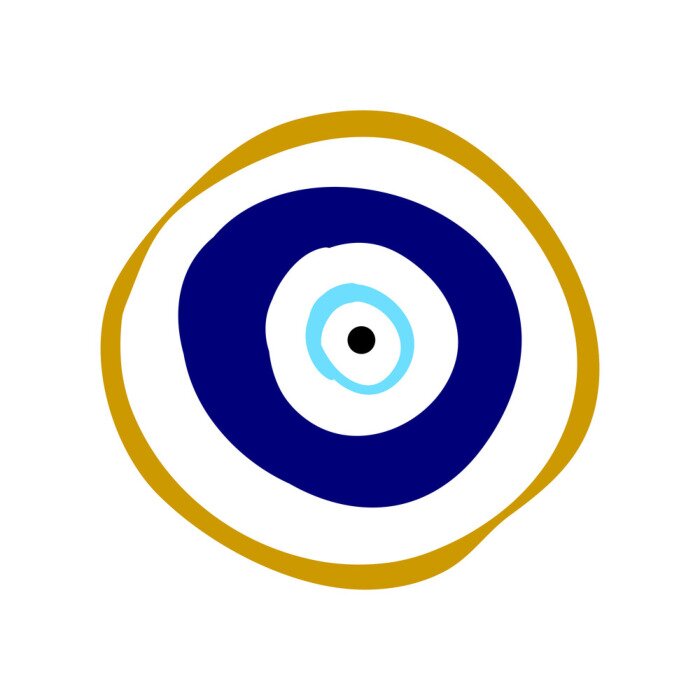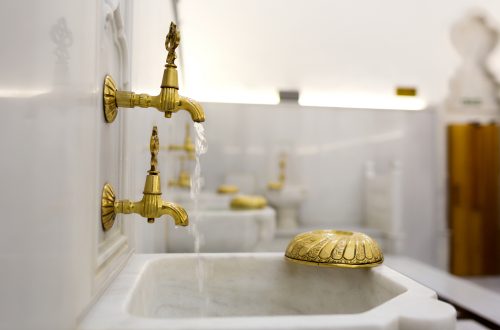
The Turkish Eye (Nazar Boncugu) is the most popular souvenir from Turkey
The Nazar Boncugu (Turkish Eye) is a small talisman in the shape of a teardrop-shaped blue eye.
You have certainly seen the symbol before.
It is universally believed to be a powerful lucky charm in Turkey.
According to Turkish popular belief, the amulet protects its wearer from the evil eye.
Its meaning can be compared to a horseshoe or a hare’s paw. The eye clearly looks nicer. That is why the Turkish eye is one of the most popular souvenirs from Turkey.
The lucky charm from Turkey, Nazar Boncugu (Turkish Eye) amulet
The word Nazar comes from the Arabic language. Its translation means something like look, see or attention.
In the Turkish language, Nazar Boncugu simply means “eye-pearl”. A common name for the Nazar amulet is the Eye of Fatima, after the youngest daughter of the prophet Mohamed.
During your vacation in Turkey, you will run into the blue amulet everywhere. The classic example is a chain with the blue eye on the inner rear-view mirror of taxis or buses.
This amulet should also help protect valuables and houses. Almost all hotels have a Turkish eye hanging over the entrance. The same goes for houses, shops and restaurants.
In the port of Bodrum, Nazar amulets are even placed in the pavement of the pedestrian zone. Just keep your eyes open and you will see the Nazar Boncugu more often than the Turkish flag in Turkey.
What is the Evil Eye actually?
Some see the blue Nazar amulet as an image of the evil eye. This is wrong. The Nazar amulet represents the benevolent look as protection from the evil eye. You cannot buy the evil eye.
The evil eye is a kind of curse. It is an answer to the age-old question of why bad things happen to good people.
The curse goes back to the millennia-old superstition that a jealous look pushes the other person into disaster. Healthy people get sick by looking at them, crystal vases break into a thousand pieces and at the next traffic light, someone crashes rear-end into the brand-new car.
According to Turkish popular belief, people with light blue eyes are said to naturally attract the evil eye. One theory is that the amulet is the counterpart to the blue eyes.
Some also believe that people with good intentions can throw the evil eye without knowing it.
Babies and children are said to be especially vulnerable to attacks from the evil eye. Therefore, nice words about how cute a child is are often associated with a machallah (will of God) to graciously show that no envy exists.
So, where does the story of the Turkish eye come from?
A 5,000-year-old clay tablet from Mesopotamia is the oldest representation of the Nazar eye.
Its importance today can be traced back to ancient Egypt since around 3,000 years. It is said to have originally symbolised the protective eye of the god Osiris and Horus.
The Evil Eye has many names. The Romans called the gaze Malus and the Greeks referred to it as Baskania. Today, the Italians call it Mallochio, the Spaniards call it Mal Ojo and in Hebrew it is called Ayin Hara. You can even find the eye in Mexico by the name Ojo de Vanado.
In Anatolia, ancient writings about the evil eye were recorded by the Hittites around 3,000 years ago.
Christians, Jews and Islam are familiar with the evil eye
Famous literary works, including the Bible, mentions the evil eye (Proverbs 23: 6: “Do not eat the bread of the one who has an evil eye, and do not ask for his tender flesh”). The evil eye also appears in the Koran and in plays by Shakespeare.
The seafaring Phoenicians and Carthaginians painted the eye as a talisman on the bow of their ships. You can still see the Horus or Osiris eye on the bow of the traditional Maltese luzzu boats. The boats have a Christian name, but the pagan eye is painted on the ships as a good luck charm.
Irish farmers hang a similarly shaped blue ball named Droch-shuil over their barn doors. It is supposed to protect animals from their neighbours’ envious gazes.
Even the “all-seeing eye of God” in the Christian faith is said to go back to the eye of Osiris and thoughts of the evil eye. We’ve all noticed the all-seeing eye on top of a pyramid on the American dollar bill.
According to UNESCO, that 36% of all cultures today know about the evil eye.
Manufacture and construction: how to make a Turkish eye
Traditional Turkish Nazar amulets are made of glass.
In the middle of the amulets is a black pupil. It is enclosed with a light blue ring. Then there is a narrow white ring and then a wide dark blue ring to close the Turkish eye.
The entire amulet is shaped like a drop of water. On the upper side, there is usually a hole for a thread to hang upon.
Traditionally, the Nazar amulets are produced from glass originating from Mesopotamia. From there, it spread through Syria to Anatolia. The first workshops were on the Turkish Aegean Sea in Bodrum and Izmir.
The village of Nazarköy in Izmir claims to be the actual birthplace of the symbol in Turkey. The following video from Turkey Home briefly shows you the village and a traditional manufacturing site.
The Turkish eye is so ubiquitous in Izmir that even the city’s logo is a Nazar amulet. Instead of a light blue ring, a yellow ring surrounds the pupil inside in Izmir. You can often see the shape of the eye along the Aegean Sea.
Unfortunately, interest in the traditional manufacture of amulets has also waned in Izmir. Cheaper and easier-to-work materials like plastic have replaced glass.
Nowadays, there are only a few factories that make the real Nazar Boncugu out of glass.
The last traditionally operated manufacturers are in the villages of Nazarköy, Cumaovasi and Görece near Izmir and in Bodrum.
Today, the amulets are available in different sizes. The smallest eyes are just as big as the head of a pin. They look like little pearls.
In addition to its normal shape, there are different variants with decorations. In Egypt the eye with a final golden rim is common. You’ll rarely see that in Turkey.
In the Middle East and in North Africa you will also find the hand of Fatima. This is the inside of a hand that is held out towards you like the stop symbol. In the middle of the hand is a Turkish eye.
In Conclusion
Millions of Turks don’t take the concept of the evil eye lightly. Others see it as: “Well, if it doesn’t help, at least it won’t do me any harm.”
For me, the little talisman is a nice touch.
The myth has made the eye one of the most popular souvenirs from Turkey. It is also a nice present for a birthday, a wedding or to wear outside when visiting with friends.
I bet that you will find stands with the amulets every 10m or so in bazaars at the holiday resorts.
Bracelets, anklets and key rings with the Turkish eye are particularly popular.
If you believe that the eye protects you from bad luck, don’t worry if it breaks.
At that very moment, it protected you from the evil eye.
You should then quickly replace it. You can buy nazar boncugu on amazon.




